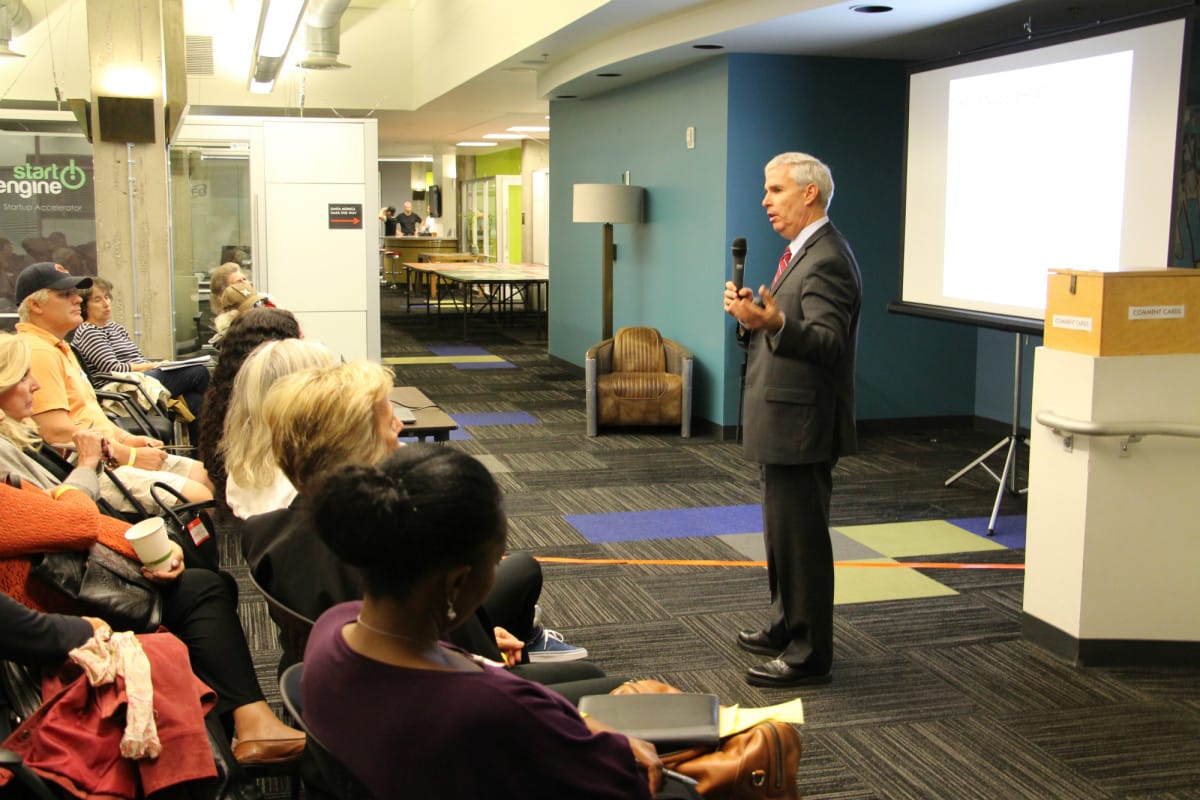
At the end of this month, Santa Monica City Manager Rod Gould will retire, rounding out five years of service in the bayside city and a three decade career in city management. Santa Monica Next sat down with Gould to talk about the last five years, his plans for the future, and the challenges facing Santa Monica. This is part one of Next’s two-part interview with Gould.
Santa Monica Next: How does it feel to be leaving after five years?
Rod Gould: I gave the Council six month’s notice of my decision and for the first three or four months, it was unreal because it was so far in the future… In the last week or so, it is coming home to me that something is finishing and that I start something very new. Just as with any transition, you have some things that you leave behind that you will miss terribly and are very much a part of who you are. On the other hand, I like change and I’m terribly excited about what comes next.
[pullquote align=left]
My advice to the incoming city manager and to this Council is, you need to find some dedicated revenue sources to continue to allow Santa Monica to lead in the area of affordable housing.
[/pullquote]SMN: What do you think your legacy in Santa Monica will be?
RG: Very few things of importance are done singly in government. Government is a team sport, so I can’t lay claim to anything that I did personally.
The thing that I am most proud of, which I think will be my legacy, is the strength of the management team that I leave. It’s not the buildings that we’ve built. It’s not the parks. It’s not the number of balanced budgets. It’s not the size of our reserves.
It’s the quality of the people that lead the organization that provide the services and activities and projects that this community counts on. They are strong, they are cohesive, and they are people of character with non-negotiable ethics. They are privileged to work in this city and they know it. They enjoy one another. They support each other in the ups and downs of the daily fray.
I will miss most working with each of them individually and in groups on a myriad of issues and projects. They are why I am very bullish about the city of Santa Monica… This management team is really something.
[pullquote align=right]
Santa Monica lost 15 percent of its revenues during this period. Having come from other cities and being engaged with professional organizations, I thought I was coming into cut-back management situation.
[/pullquote]SMN: You came to Santa Monica during the national recession. What were your thoughts and concerns when you started here as city manager?
RG: It was January of 2010, the recession was two years old and because many municipal revenues modulate with the economy slowly, the effects [of the recession] were just becoming known across California and the nation.
Santa Monica lost 15 percent of its revenues during this period. Having come from other cities and being engaged with professional organizations, I thought I was coming into cut-back management situation. I thought I was going to have to preside over the first series of layoffs since 1992. I thought I was going to have to have the [City] Council decide to do less of a lot of important things, stop doing things that were dear to them, and to hunker down to get through a recession that I didn’t know how long it was going to last.
I underestimated the strength of the local economy. Santa Monica went in [to the recession] later than most cities and came out sooner.
I was also fortunate to be here as the tech boom occurred. I’d like to say that was part of some long-range plan that the city had. It was not. This happened organically and part of the reason is how attractive Santa Monica is as a place to live, work, and play.
We also made some good decisions along the way. We worked on both sides of the ledger. We stripped out some of the unnecessary expenses. We cut the budget by about $25 million in the early years, but we did it so surgically that no one could tell the difference.
We also went to the voters for a tax measure in fall of 2010 to shore up the city’s side, but also to help out the schools, which had suffered a terrible defeat over a parcel tax that lost by two-tenths of one percent or something ridiculous like that.
[pullquote align=left]
Most cities would kill for the opportunities that Santa Monica fights over daily. Many of the opportunities in development or finance that have been quite controversial here would have been approved overnight in most cities because they brought jobs, they brought opportunity, they brought revenue, they brought stability.
[/pullquote]SMN: What was the measure that passed?
RG: That was Measure Y. This raised the sales tax by half of one percent. Measure YY was the companion advisory measure that said, and this is not binding, to the city, “If Measure Y passes, shouldn’t it be split 50-50 with the schools for education purposes?”
Both passed handily. That funding source has allowed the schools to strengthen at a time when they were hurting. It also helped stabilize the city.
We were able to, whenever we saved money, to build back our reserves… and to get the Council in the habit of paying down future liabilities, such as our pension liabilities for our large workforce.
I also convinced the Council that, despite the fact that the employees were used to four and five percent [salary] increases every year, to give them what inflation was going to take and a little bit more, that we could no longer afford this, that we were already very well paid and that maybe we should just hold the line and keep up with inflation.
While that looked meager to some, it ended up turning out to be quite good for everybody because most cities didn’t even provide cost-of-living increases. So, Santa Monica floated to the top of the chart. That allowed us to attract some really good talent during this period and that meant that very few people left us. That strengthened the organization as well.
[pullquote align=right]
In the last 30 years, 38 percent of the housing that’s been built in town is considered affordable by one definition or another. That’s pretty darn good. That helps keep Santa Monica different than some of the elitist communities along the shores in California.
[/pullquote]SMN: Santa Monica has long been committed to keeping the city economically diverse, but it no longer has a revenue stream to help fund affordable housing construction and preservation. What advice would you give to the incoming city manager about this?
RG: My advice to the incoming city manager and to this Council is, you need to find some dedicated revenue sources to continue to allow Santa Monica to lead in the area of affordable housing.
The economic forces at play here will overwhelm almost any attempt to provide even a modicum of affordable housing in this city unless you have a robust program. And even at that point, it will be very hard to find land and existing buildings that you can buy and use for that purpose.
But, you must do this if you want to keep the essence of Santa Monica… At the Council meeting next Tuesday, we’re recommending that the Council begin to put some of those streams in place, but it’s a pittance compared to what [Santa Monica’s Redevelopment Agency] used to yield.
SMN: Something like $15 million a year.
RG: Yes. Fifteen million plus a year. The Redevelopment Housing Trust Fund, which is the main source of the monies to buy… the land and partner with nonprofits to build quality affordable housing. We think we’ve got about two years of money left in it.
That gives the city and the community a couple years to figure out what else is there. We have some thoughts about that I’m not ready to put out in your paper, but the community needs to figure this out.
Measures H and HH failed at this last election. Maybe it was the wrong tax; maybe it was the wrong time; maybe the campaign wasn’t quite right. I don’t know, but I do think it’s really important that Santa Monica keep after this and I have every expectation that it will.
Unless you’re self-sufficient, unless you have the dedicated revenue sources, unless you’ve got people who are working it day-to-day, unless you have strong partnerships with the private sector and nonprofits, unless you are constantly looking for every opportunity, you can’t make a dent.
Santa Monica has done more than make a dent. In the last 30 years, 38 percent of the housing that’s been built in town is considered affordable by one definition or another. That’s pretty darn good. That helps keep Santa Monica different than some of the elitist communities along the shores in California.
SMN: Outside of the affordable housing issue, what do you think will be the most pressing issue facing your successor?
RG: I think the biggest issue facing my successor is the politics of abundance. There is an abundance of resources in this city. There is an abundance of financial as well as human assets in town. There is an abundance of opportunities, so choosing amongst them and making the best choices for the long-term health of the city is probably the biggest challenge.
Most cities would kill for the opportunities that Santa Monica fights over daily. Many of the opportunities in development or finance that have been quite controversial here would have approved overnight in most cities because they brought jobs, they brought opportunity, they brought revenue, they brought stability.
Santa Monica has the opportunity to be the choosiest of cities, to pick only the best of the best. I’m just hoping that it will.
This interview was edited for clarity and length.

